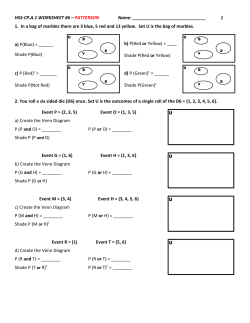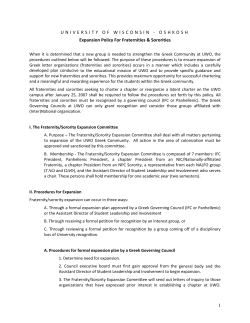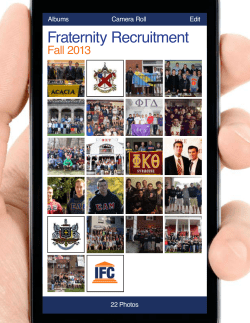
Chapter 5 Practice Test Problems Name___________________________________ SHORT ANSWER. Write the word or phrase that best completes each statement or answers the question.
Chapter 5 Practice Test Problems
Name___________________________________
SHORT ANSWER. Write the word or phrase that best completes each statement or answers the question.
Suppose that A = {1, 3, 5, 7, 9}, B = {1, 3, 7}, and U = {1, 2, 3, 4, 5, 6, 7, 8, 9}.
List the elements of the indicated set.
1) B′
1)
2) A ∩ B′
2)
3) A ∪ A′
3)
Solve the problem.
4) List all the subsets of {1, 2, 3, 4} which do not include 3.
4)
5) List all the subsets of {+, - , ×, ÷}.
5)
Let U = {1, 3, 5, 7, 9, 11}, A = {1, 5, 9, 11}, B = {3, 5, 7}, and C = {1, 3, 11}.
List the elements of the indicated set.
6) U ∩ B
6)
7) A′ ∪ B ∪ C
7)
Suppose that U = {a, b, c, d, e}, Α = {a, e}, B = {a, b}, and C = {a, b, c}.
List the elements of the indicated set.
8) A ∪ B ∪ C
8)
9) (A ∪ B) ∩ C′
9)
Let U = {cars}, A = {cars manufactured in the United States}, B = {cars with automatic transmissions}, and C =
{convertibles}. Describe the indicated set in words.
10) A′
10)
11) Β ∪ C
11)
Let U = {students}, A = {male students}, B = {varsity students}, and C = {Deanʹs list students}. Describe the indicated set
using set-theoretic notation.
12) {student who are male or on the Deanʹs list}
12)
Let U = {all voters}, A = {those who voted in the last election}, B = {those who voted Democrat in the last election}, and C
= {voters under 30 years of age}. Describe the indicated set.
13) A ∩ C
13)
14) A′ ∪ C
14)
1
Let U = {all people}, A = {all American citizens}, B = {people who do not live in their country of citizenship}, C = {German
citizens}, and D = {all people living in the United States}. Describe the indicated set using set -theoretic notation.
15) {American citizens living abroad}
15)
16) {Those people with dual American-German citizenship}
16)
Solve the problem.
17) Find n(S ∪ T), given that n(S) = 10, n(T) = 6, and n(S ∩ T) = 5.
17)
18) Find n(A ∪ B) if n(A) = 12, n(Β) = 5, and n(A ∩ B) = 3.
18)
19) In a survey of 1000 people, it was found that 720 watched television news programs daily
and 434 read a newspaper daily. How many of those surveyed used both media to receive
news?
19)
20) At a certain business, 300 employees can type or use the required software. If 155
employees can type and 175 can use the software, how many can both type and use the
software?
20)
21) Draw a two-circle Venn diagram and shade the portion corresponding to the set B′ .
21)
22) Draw a two-circle Venn diagram and shade the portion corresponding to the set ( A ∪ B) ∩
B′.
22)
23) Draw a three-circle Venn diagram and shade the portion corresponding to the set ( A ∪ B)
∩ C′.
23)
24) Draw a three-circle Venn diagram and shade the portion corresponding to the set ( A ∪ B′)
∩ C.
24)
25) Give a set-theoretic expression that describes the shaded portion of the Venn diagram
shown below.
25)
26) Give a set-theoretic expression that describes the shaded portion of the Venn diagram
shown below.
26)
2
A survey was made to determine the popularity of hockey, baseball and football. Of those surveyed, 35% watched
hockey, 58% watched baseball, and 47% watched football. 15% watched hockey and baseball, 20% watched baseball and
football, and 22% watched hockey and football. 7% watched all three sports.
27) What percentage watched hockey and football, but not baseball?
27)
A survey of 100 bank customers revealed that 58 of them have a savings account, 63 of them have a checking account, 22
of them have a savings account and a loan, 16 of them have a checking account and a loan, 27 of them have only a
checking account, 12 have a savings account and a checking account and a loan. Assume that every customer has at least
one of the services.
28) Determine the number of customers who have a checking account but no savings account.
28)
29) Determine the number of customers who have checking or savings accounts but no loans.
29)
Solve the problem.
30) One hundred male college students were surveyed. Twenty of the students were members
of a fraternity, 5 were honors students, 77 were neither members of a fraternity nor honors
students, and 18 were members of a fraternity but not honors students.
(a) Draw a Venn diagram displaying the given data and the number of elements in each
basic region.
(b) How many honors students do not belong to a fraternity?
(c) How many fraternity members are honors students?
30)
31) A certain clinic has 400 patients, each of whom is being treated for heart disease or
diabetes. Suppose that 300 are treated for heart disease and 75 are treated for heart disease
and diabetes.
(a) How many patients are treated for diabetes?
(b) How many patients are treated only for heart disease?
31)
32) Of 95 students, 62 are foreign, and of those 62 foreign students, 23 are female. If 45 of the
students are male, how many female students are not foreign?
32)
33) Let R, S, and T be subsets of the universal set U. Draw a Venn diagram and use the data
given below to label the number of elements in each basic region.
n(U) = 68, n(R ∪ S ∪ T) = 56, n(R ∩ T′) = 30, n(R ∩ S) = 12, n(R ∩ T) = 5, n(S ∩ T′) = 15, n(S′ ∩ T) = 9, and n(R ∩ S ∩ T) = 4.
33)
34) Let n(U) = 100, n(A) = 48, n(B) = 47, n(C) = 32, n(Α ∩ B) = 22, n(Α ∩ C) = 10, n(B ∩ C) = 14,
and n(Α ∩ B ∩ C) = 4.
(a) Draw a Venn diagram displaying the given data and the number of elements in each
basic region.
(b) Determine n(A ∩ B ∩ C′).
(c) Determine n((A ∪ B)′).
34)
3
35) Let n(U) = 53, n(A) = 20, n(B) = 15, n(C) = 27, n(Α ∩ B) = 10 , n(Α ∩ C) = 7, n(B ∩ C) = 8, and
n(Α ∩ B ∩ C) = 6.
(a) Draw a Venn diagram displaying the given data and the number of elements in each
basic region.
(b) Determine n(A ∩ B ∩ C′).
(c) Determine n((A ∪ B ∪ C)′).
35)
For the question(s) below, let n(A ∪ B) = 50, n(Β) = 20, n(Α) = 45, and U = A ∪ B.
36) Find n(A′ ∪ B′).
36)
37) Find n(A ∩ B).
37)
Solve the problem.
38) Let n(U) = 100, n(A) = 24, n(A ∪ B) = 74, and n(A ∩ B) = 10.
(a) Determine n(B).
(b) Determine n(B′).
(c) Determine n(A′ ∪ B′).
38)
39) A grand jury questioned 70 persons. Forty were lawyers, 23 were women, and 21 were
under indictment. There were 12 female lawyers, 5 indicted women, and 14 indicted
lawyers. Two of the indicted lawyers were women.
(a) Draw a Venn diagram displaying the given data and the number of elements in each
basic region.
(b) How many of the lawyers were not under indictment?
(c) How many of the indicted women were not lawyers?
39)
40) Blood samples of 100 people were tested. The A, B and Rh antigens were found in the
blood of 32, 33, and 74 people, respectively. None of the antigens was found in 13 samples.
Ten samples contained the A and Rh antigens only, 9 contained the B and Rh antigens
only, 6 contained the B antigen only and 3 contained the A and B antigens only.
(a) Draw a Venn diagram displaying the given data and the number of elements on each
basic region.
(b) How many samples contained the A and B antigens?
(c) How many samples do not contain the Rh antigen?
40)
41) How many different outfits can be selected from 3 suits, 5 shirts, and 2 hats?
41)
42) How many 4-letter words can be made from the letters of ʺMISSISSIPPIʺ if the words
must begin with an S and letters cannot be repeated?
42)
43) How many four-digit sequences can be formed allowing no repetition of digits?
43)
44) Assuming that you can get a customized license plate where there it must consist of a
distinct letter followed by any combination of four letters or digits, how many different
custom license plates can be printed?
44)
4
45) Area codes in the United States are three-digit numbers where the first digit is not a 0 or a
1. Assuming that the middle digit can be any number, how many codes are possible?
(Some of these are not used.)
45)
46) Area codes in the United States are three-digit numbers where the first digit is not a 0 or a
1, and the middle digit is either 0 or 1. How many codes are possible? (Some of these are
not used.)
46)
47) Toss a coin four times. How many possible sequences of heads or tails are there?
47)
48) Consider an alphabet with 30 distinct letters. How many three -letter words can be formed
allowing repetition of letters?
48)
49) How many five-digit codes are there with no repeated digits?
49)
50) A college student wants to select one foreign language course from among four possible
courses, one math course from among seven possible courses, and one economics course
from among five possible courses. In how many different ways can she select the three
courses?
50)
51) An organization can elect a president and a different vice -president in 350 different ways.
How many members does the organization have?
51)
52) The letters of the word ʺMATHʺ are arranged in a random order.
(a) How many different arrangements are possible?
(b) How many start with a vowel?
(c) How many start with ʺAʺ and end with ʺHʺ?
52)
53) How many four-letter words can be made from the letters of ʺMISSISSIPPI,ʺ if
(a) letters can be repeated?
(b) letters cannot be repeated?
53)
54) You are to create a secret four-digit code for your ATM card using the digits 0 to 9.
(a) How many different codes can be made?
(b) If you are only allowed to use a digit once, how many different codes can be made?
54)
55) Calculate C(4, 4) + C(4, 3) + C(4, 2) + C(4, 1) + 1.
55)
56) Calculate P(3, 3).
56)
57) Calculate C(6, 0).
57)
58) Calculate 10!.
58)
59) List all the permutations of the letters in the word ʺCATSʺ taken two at a time.
59)
5
60) How many two-letter combinations can be made from the letters in the set {a, b, c , d}?
List all of them.
60)
61) How many different signals may be formed from five different colored flags if a signal
consists of three different colored flags arranged in a particular order?
61)
62) A pizza parlor offers five toppings on its pizza. How many different pizzas are there with
three or four toppings?
62)
63) In how many different ways can a student choose six questions to answer from a test with
eight different questions?
63)
64) How many ways can 7 of 10 books be arranged on a shelf?
64)
65) In how many ways can a committee of 12 senators be selected from the 100 members of
the United States Senate so that no two committee members are from the same state? (Do
not evaluate.)
65)
66) In how many ways can you choose two groups of three people from among eight people?
66)
67) How many ways can 100 balls be put into three3 boxes with 50 balls going into one box
and 25 into each of the other two? (Do not evaluate.)
67)
68) In the street map shown below, how many of the routes from A to B pass through C (with
no backtracking)?
68)
69) In how many ways can a jury of 12 people be chosen from an available pool of fourteen
women and six men if the jury must consist of eight women and four men?
69)
70) A coin is tossed eight times and the sequence of heads and tails is observed.
(a) How many different outcomes are possible?
(b) How many different outcomes have exactly two tails?
(c) How many different outcomes have at least two tails?
70)
6
71) There are 25 quarts of milk on a supermarket shelf, four of which are spoiled. A customer
buys three quarts of milk.
(a) How many samples are possible?
(b) How many samples contain exactly two quarts of spoiled milk?
(c) How many samples contain at least two quarts of spoiled milk
71)
72) An urn contains four red balls and six white balls. A sample of four balls is selected.
(a) How many samples are possible?
(b) How many samples contains exactly three white balls?
(c) How many samples contain four white balls?
72)
7
Answer Key
Testname: MTH 110 CHAPTER 5 PRACTICE TEST PROBLEMS
1)
2)
3)
4)
5)
6)
7)
8)
9)
10)
11)
12)
13)
14)
15)
16)
17)
18)
19)
20)
21)
{2, 4, 5, 6, 8, 9}
{5, 9}
U = {1, 2, 3, 4, 5, 6, 7, 8, 9}
∅, {1}, {2}, {4}, {1, 2}, {1, 4}, {2, 4}, {1, 2, 4}
∅, { + }, { - }, { × }, { ÷ },
{+, - }, { +, ×}, { +, ÷}, { -, ×}, {-, ÷ }, { ×, ÷},
{ +, -, ×}, {+, -, ÷ }, { +, ×, ÷}, { -, ×, ÷ }, {+, -, ×, ÷}
B
{1, 3, 5, 7,11}
{a, b, c, e}
{e}
{cars manufactured outside the United States}
{cars which have automatic transmission or are convertibles}
A ∪ C
{those voters under 30 who voted in the last election}
{those voters who did not vote in the last election or are under 30 years old}
A ∩ B
A ∩ C
11
14
154
30.
22)
23)
24)
25)
26)
27)
28)
29)
(A ∪ B) ∩ C′
R′ ∩ (S ∪ T)
15%
31
63
8
Answer Key
Testname: MTH 110 CHAPTER 5 PRACTICE TEST PROBLEMS
30) (a)
(b)
(c)
31) (a)
(b)
32) 27
33)
3
2
100
225
34) (a)
(b) 18
(c) 27
35) (a)
(b) 4
(c) 10
36) 35
37) 15
38) (a) 60
(b) 40
(c) 90
9
Answer Key
Testname: MTH 110 CHAPTER 5 PRACTICE TEST PROBLEMS
39) (a)
(b) 26
(c) 3
40) (a)
41)
42)
43)
44)
45)
46)
47)
48)
49)
50)
51)
52)
53)
(b) 18
(c) 26
30
6
10 · 9 · 8 · 7 = 5040
26 · 36 · 36 · 36 · 36 = 43,670,016
8 · 10 · 10 = 800
8 · 2 · 10 = 160
16
27,000
10 · 9 · 8 · 7 · 6 = 30,240
140
26
(a) 4! = 24
(b) 6
(c) 2
(a) 4 4 = 256
(b) 4! = 24
54) (a) 104 = 10,000
(b) 10 · 9 · 8 · 7 = 5040
55) 1 + 4 + 6 + 4 + 1 = 16
56) 6
57) 1
58) 3,628,800
59) CA AC TC SC
CT AT TA SA
CS AS TS ST
60) C(4, 2) = 6
{a, b}, {a, c }, {a, d}, {b, c }, { b, d}, {c, d}
61) P(5, 3) = 5 · 4 · 3 = 60
62) C(5, 4) + C(5, 3) = 5 + 10 = 15
63) C(8, 6) = 28
64) P(10,7) = 10 · 9 · 8 · 7· 6 · 5 · 4 = 604,800
10
Answer Key
Testname: MTH 110 CHAPTER 5 PRACTICE TEST PROBLEMS
C(50, 12) · 2 12
C(8, 3) · C(5, 3) = 560
C(100, 50) · C(50, 25)
30
C(14, 8) · C(6, 4) = 45,045
70) (a) 2 8 = 256
(b) C(8, 2) = 28
(c) 256 - 9 = 247
71) (a) C(25, 3) = 2300
(b) C(4, 2) · C(21, 1) = 126
(c) C(4, 2) · C(21, 1) + C(4, 3) · C(21, 0) = 130
72) (a) C(10, 4) = 210
(b) C(6, 3) · C(4, 1) = 80
(c) C(6, 4) = 15
65)
66)
67)
68)
69)
11
© Copyright 2025





















